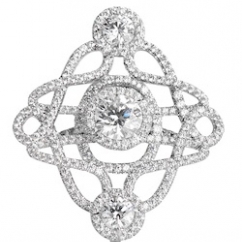Articles and News
Global Diamond Report: Industry Handled 2020 The Right Way And Is Well Set Up To Forge Ahead | February 10, 2021 (0 comments)

Antwerp, Belgium—Few people other than perhaps Amazon shareholders will look back at 2020 with any degree of fondness, but after several challenging years, the diamond industry did a lot of things right in 2020. As such, it avoided some of the worst fates facing other sectors. Image: Forevermark Deco-inspired ring
The 10th annual report on the global diamond industry, prepared by the Antwerp World Diamond Centre (AWDC) and Bain & Company, was released this week. It covers a wide scope: industry performance in 2019, effects of the Covid-19 pandemic in 2020, an update on consumer preferences and attitudes, potential economic recovery scenarios in 2021, and a long-term outlook for the diamond industry through 2030.
While the diamond industry suffered during the Covid-19 crisis, it fared much better than the personal luxury market overall. The crisis prompted necessary structural changes in the diamond industry that will help it recover from the recession, such as midstream inventories finally at healthy levels and better aligned with consumer demand.
Because major miners canceled sales in the first half of 2020 and allowed clients to postpone purchases, it helped midstream players not only weather the worst of the storm but to come out in a stronger position. The midstream entered 2019 with challenges in inventory backlog but efforts throughout the year paid off: players went into 2020 with 9% less inventory, healthier financial balance sheets, and a more consolidated market structure. In 2020, they further reduced stockpiled inventories by 22%.
Divergence between rough and polished prices also helped many in the midstream post record-high operating margins in 2020, and by the end of the year high-quality diamonds had recovered most of their price drops of the past two years, even ending the year in positive territory, says the report.
The financial picture is much better too. The midstream segment lowered its debt by half compared to its peak level in 2013; debt levels decreased to $8 billion in 2020, due to both lower trading levels and a higher reliance on self-financing. Larger midstream companies with transparent operations continued to access financing from big banks, while alternative financing options (e.g., peer-to-peer financing) emerged for smaller players, says the report. Deleveraging is expected to speed up restructuring and consolidation of the midstream, and better financial health across the sector is expected to create long-term benefits across the pipeline.
Because of the pandemic and restricted travel, consumers were redirected to local and online retailers. They also retrenched on emotional giving, valuing diamond jewelry as both a desirable gift and a key element of marriage. In a 2020 Bain survey, U.S. consumers said jewelry and watches are among the top four gifts they would like to receive, while consumers in China and India ranked them in the top two.
In all three regions, 60% to 70% of respondents believe diamonds are an essential part of an engagement, and 75% to 80% of consumers said they intend to spend the same amount or more on diamond jewelry post-pandemic than they would have before the crisis.
U.S. holiday sales for 2020 bore this out, with American retailers overall experiencing a 5% to 10% increase over 2019 holiday figures (and even better in the high-end sector.)
Related: Season Totals Astound Jewelers
There also are more partnerships between upstream and midstream players in technology, go-to-market strategies, and marketing, says the report. A more transparent and digitally enabled supply chain was created in the rough and polished diamond segments, along with innovative new approaches to customer engagement. Overall, analysts are optimistic these changes will help the industry exit the crisis in a stronger position.
Heading into 2021, the report says most miners reported 5%–8% rough diamond price and sales improvement in January, while in addition major miners kept a flexible sales policy. Together, this sets up a good start to the year and if that trajectory continues, the industry could see faster recovery than anticipated in an optimistic scenario, says the report.
But headwinds remain: There is still a lot of economic uncertainty ahead, warns the report. The current crisis could be more severe than 2009, and a double-dip recession is possible. Three factors will impact the pace and shape of the recovery: epidemiology, government policy response and consumer response. Despite optimism, full recovery and a return to historic growth trajectory isn’t expected until 2022–24. Even after the consequences of the pandemic are fully mitigated, industry players must continue to restructure their business models to align with long-term trends and operational realities, says the report. The industry needs to embrace digital technologies, explore new marketing concepts, and engage consumers differently to capitalize on long-term growth prospects.







